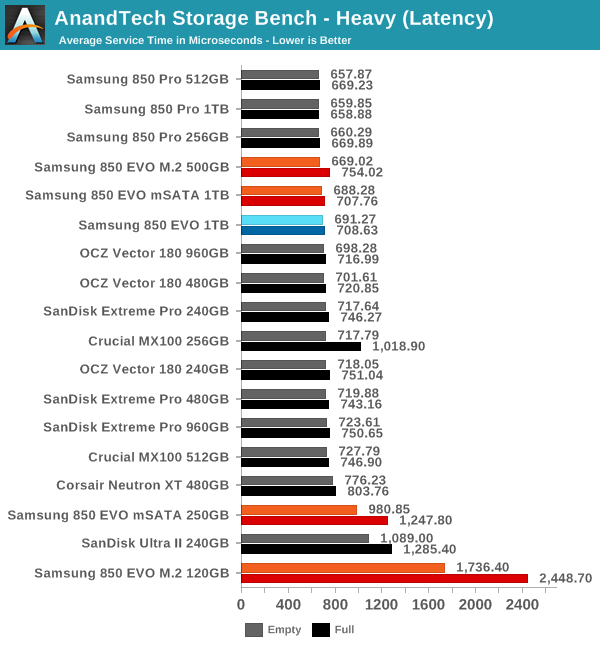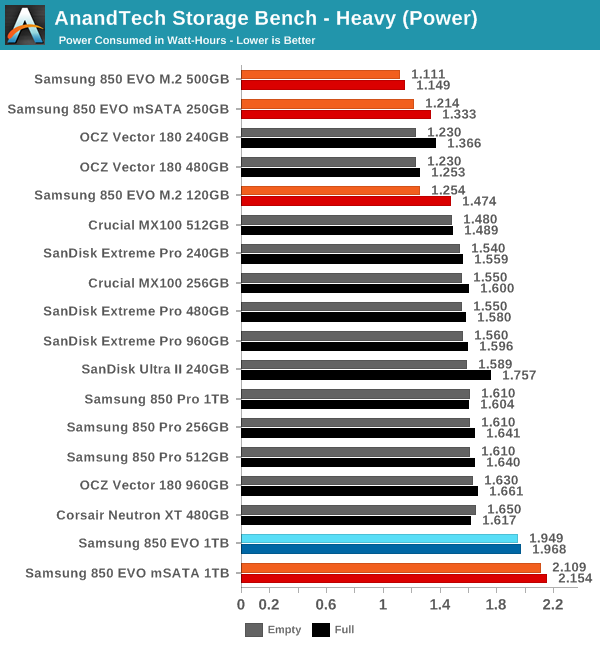The Samsung SSD 850 EVO mSATA/M.2 Review
by Kristian Vättö on March 31, 2015 10:00 AM ESTAnandTech Storage Bench - Heavy
While The Destroyer focuses on sustained and worst-case performance by hammering the drive with nearly 1TB worth of writes, the Heavy trace provides a more typical enthusiast and power user workload. By writing less to the drive, the Heavy trace doesn't drive the SSD into steady-state and thus the trace gives us a good idea of peak performance combined with some basic garbage collection routines.
| AnandTech Storage Bench - Heavy | ||||||||||||
| Workload | Description | Applications Used | ||||||||||
| Photo Editing | Import images, edit, export | Adobe Photoshop | ||||||||||
| Gaming | Pllay games, load levels | Starcraft II, World of Warcraft | ||||||||||
| Content Creation | HTML editing | Dreamweaver | ||||||||||
| General Productivity | Browse the web, manage local email, document creation, application install, virus/malware scan | Chrome, IE10, Outlook, Windows 8, AxCrypt, uTorrent, AdAware | ||||||||||
| Application Development | Compile Chromium | Visual Studio 2008 | ||||||||||
The Heavy trace drops virtualization from the equation and goes a bit lighter on photo editing and gaming, making it more relevant to the majority of end-users.
| AnandTech Storage Bench - Heavy - Specs | ||||||||||||
| Reads | 2.17 million | |||||||||||
| Writes | 1.78 million | |||||||||||
| Total IO Operations | 3.99 million | |||||||||||
| Total GB Read | 48.63 GB | |||||||||||
| Total GB Written | 106.32 GB | |||||||||||
| Average Queue Depth | ~4.6 | |||||||||||
| Focus | Peak IO, basic GC routines | |||||||||||
The Heavy trace is actually more write-centric than The Destroyer is. A part of that is explained by the lack of virtualization because operating systems tend to be read-intensive, be that a local or virtual system. The total number of IOs is less than 10% of The Destroyer's IOs, so the Heavy trace is much easier for the drive and doesn't even overwrite the drive once.
| AnandTech Storage Bench - Heavy - IO Breakdown | |||||||||||
| IO Size | <4KB | 4KB | 8KB | 16KB | 32KB | 64KB | 128KB | ||||
| % of Total | 7.8% | 29.2% | 3.5% | 10.3% | 10.8% | 4.1% | 21.7% | ||||
The Heavy trace has more focus on 16KB and 32KB IO sizes, but more than half of the IOs are still either 4KB or 128KB. About 43% of the IOs are sequential with the rest being slightly more full random than pseudo-random.
| AnandTech Storage Bench - Heavy - QD Breakdown | ||||||||||||
| Queue Depth | 1 | 2 | 3 | 4-5 | 6-10 | 11-20 | 21-32 | >32 | ||||
| % of Total | 63.5% | 10.4% | 5.1% | 5.0% | 6.4% | 6.0% | 3.2% | 0.3% | ||||
In terms of queue depths the Heavy trace is even more focused on very low queue depths with three fourths happening at queue depth of one or two.
I'm reporting the same performance metrics as in The Destroyer benchmark, but I'm running the drive in both empty and full states. Some manufacturers tend to focus intensively on peak performance on an empty drive, but in reality the drive will always contain some data. Testing the drive in full state gives us valuable information whether the drive loses performance once it's filled with data.

In the Heavy trace the 850 EVO scores highly. As I've said before, it seems that only Samsung has found the secret recipe to boost performance under SATA 6Gbps because no other manufacturer comes close to it in this benchmark.

Moving on to latency and the 850 EVO still keeps its lead compared to other manufacturers' drives. The difference is nowhere near as significant as in the throughput metric above, but the 850 EVO is still without a doubt one of the highest performing drives on the market. The smaller capacities are a bit of a disappointement, though, because the 250GB mSATA loses to MX100 by a quite hefty margin, but it still beats the Ultra II for what it's worth.

The smaller capacities, especially the 120GB one, seem to have quite a few high latency IOs. I wouldn't say the situation for the 250GB model is critical, but I do think that individuals with heavier workloads should focus on the 500GB and higher capacities in order to avoid any storage performance issues.

But in terms of power the 850 EVO is very efficient at smaller capacities. Given that mSATA and M.2 standards are mostly used in mobile applications, this is very good news.










58 Comments
View All Comments
nmm - Tuesday, March 31, 2015 - link
Uninteresting releases like this are the reason M.2 is having so much trouble gaining traction. Desktop users have no reason to choose the M.2 variant since they'll get similar performance out of a much more versatile SATA variant. The only obvious reason I can see to buy mSATA/M.2 versions of this drive is if you've got a laptop that can't slot a regular 2½" SATA drive. What a waste of shelf space.bricko - Tuesday, March 31, 2015 - link
These are all way slow and almost outdated. INTEL and others coming out with NVMe and PCIe 3 stuff that are 2 to 4 times as fast. Big event from INTEL listed here.http://www.pcper.com/news/General-Tech/PCPer-Live-...
Best to have an X99 mobo to make them bootable. Lots of these m.2 stuff is not bootable without lots of bios messing etc. Lots of info here
http://www.thessdreview.com/our-reviews/intel-ssd-...
http://hothardware.com/reviews/Intel-SolidState-Dr...
blanarahul - Tuesday, March 31, 2015 - link
Those drives will cost upwards of 0.8$/GB. So you can't really compare those drives with these ones.Not to mention, they would be HHHL cards instead of M.2 and they use 20nm NAND which is almost 2 generations old.
bricko - Tuesday, March 31, 2015 - link
Many of the m.2 sticks run very hot and manu are insertin g them into adapter cards to fit in pcie slot.Here is link to one....but its been removed from server and being sold before the consumer version is out. The cost is enormous because no other supply yet, but should be out to consumer in day or 2.
http://www.amazon.com/dp/B00L0LFKQW/ref=wl_it_dp_o...
here is m.2 adapter card with heat sink for the samsung 941 ssd drive to put into pcie slot
http://www.amazon.com/Sintech-PCI-e-Adapter-Samsun...
but again, these early ones are difficult to make bootable, need x99 mobo and to get the nvme you need windows 8.1 which has native driver.
bricko - Tuesday, March 31, 2015 - link
Here is link to intels countdown clock for their big announcement on m.2 ssdhttp://www.intelgamingpromo.com/intel15b/ssd/notic...
bricko - Wednesday, April 1, 2015 - link
Mushkin Hyperion M.2 SSD Reaches 2.8GB/s and 350K IOPShttp://www.thessdreview.com/daily-news/latest-buzz...
Kristian Vättö - Wednesday, April 1, 2015 - link
While I'm under NDA for that announcement, what I can tell you is that there's no M.2 coming tomorrow.bricko - Wednesday, April 1, 2015 - link
Good explanation on how and what these new m.2 drives are and what you need to get them to work.http://www.tomshardware.com/answers/id-2468965/ssd...
SunLord - Tuesday, March 31, 2015 - link
I was so hoping to see a m.2 42mm option from Samsung...WackyDan - Tuesday, March 31, 2015 - link
Same here... So these aren't available in 42mm?